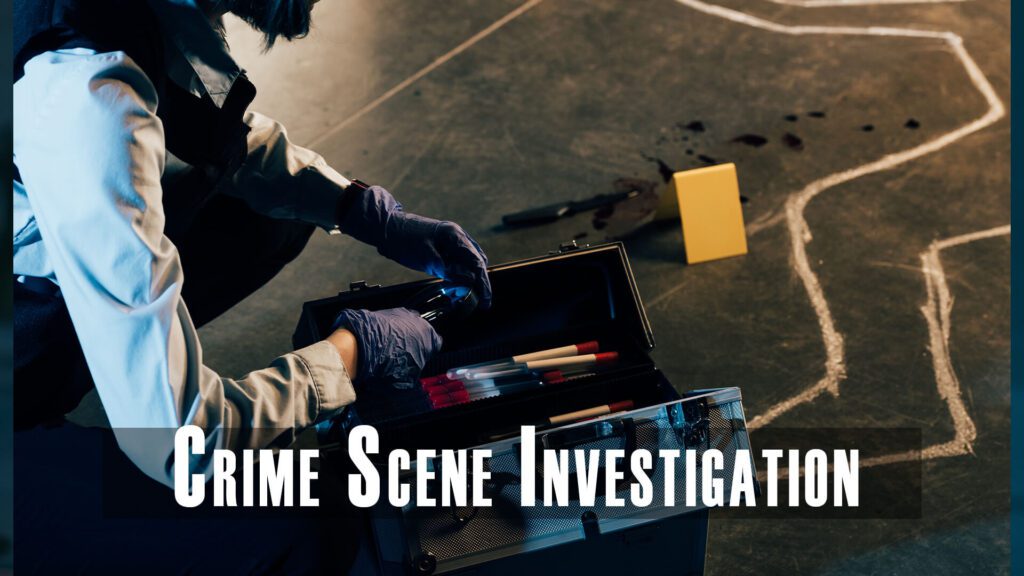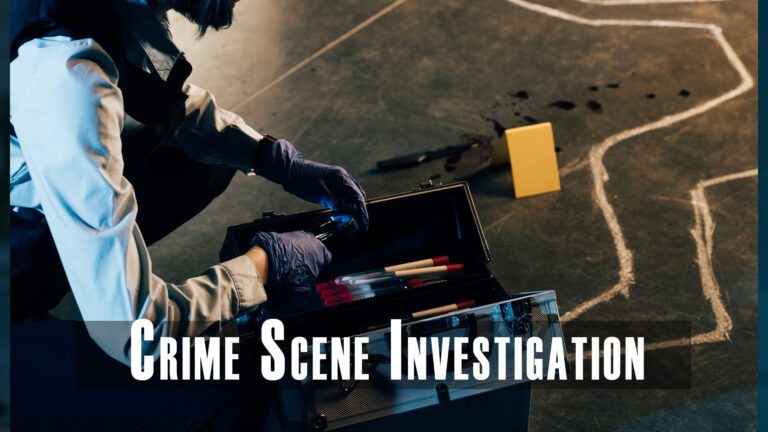As we know, it is the world of crime, and we see many crime cases every day. In the crime scene inquiry, there are many steps and things that are involved. These are forensic science tools, actions, and procedures that are used to investigate a crime scene. Forensic is the branch of science that is used to answer questions related to a legal organization. It is also used to answer all the queries related to crime and public activities.

Forensic science includes the known educated or scientific procedures and values. These are used to determine the facts related to an incident. It is also used to fix physical objects, as the case may be.
Concept of Forensic Science in Crime Scene Investigation:
The term refers, therefore, to the idea of verification. According to it, there is an extra-legal concern in defining whether an item is what it claims to be.
In Roman periods, a criminal summons meant offering the case to a group of civilians in the forum—both the person suspicious of the crime. Then the suspect made speeches based on their form of actions.
The person who delivers the best arguments will decide the result. It is the cause of two recent practices of the word as a type of legal proof or civil performance.
Investigators who do special training and education are involved in many investigations. They do the investigation of crime scenes, paper inspections, and environmental studies.
Ballistics and Firearms:
The projectiles such as gravity bombs, bullets, missiles, etc. are used to achieve the wanted action. A ballistic body is free to move, perform and is adapted in changing form. It can be done by using safe situations and substances.
The firearm is a weapon like a starter gun that is planned to expel a projectile by a volatile action.
The following websites provide information about firearm and ballistic:
Affiliation of Firearm and Tool Mark Inspectors:
It is a professional association for people who are related to forensic ballistics dome. It contains material, news, and links about ballistics.
Firearms ID and Forensic Ballistics:
The site FirearmID.com has info related to the identification of firearms. The information is about the identification of cases, bullets that have been fired. The site also describes the role of a skilled observer.
Crime Scene Investigation Resources
Affiliation for Crime Scene Renovation:
It is the affiliation that inspires the interchange of data and processes. These are important for the renovation of criminal sites.
Crime & Evidence:
Many articles talk about the art of criminal inquiry. The inquiry covers many types of signs like physical, finger impression, statement, and behavior.
Crime Scene Cleanup:
A group committed to sympathetically, securely, and inconspicuously restoring a scene to a secure state.
Point Forensics:
It provides a variety of apparatus, tools, and materials.
Global Crime Scene Inspectors Affiliation:
Supports law administration employees who are involved in this function of investigation.
Worldwide Homicide Investigator Affiliation:
It supports law administration organizations and death examination experts. It provides guidance, training, assets, and knowledge that will improve their capability to resolve cases.
Document Auditors:
It encourages education, endorses scientific investigation, and creates principles. Besides this, exchange experiences guide the analysis of the documents. It also encourages the judiciary on matters related to document issues.
American Civilization of Crime Laboratory Executives:
The institute provides mentorship in the administration of forensics to give superiority in science investigations.
Evidence Collection, Storage, and Processing
Finding evidence is the method of using things that include:
- Are believed to be true?
- They prove by evidence to confirm the truth of a report.
There are many types and places of evidence, so collection procedures vary according to them. Finding the evidence without damage is the main role of evidence gathering. It should be correctly handled to avoid any damage.
Crime Scene Processes:
It includes evidence gathering, methods, and a series of custody processes.
1. crimesceneinvestigator.net:
It is a good website having a variety of assets for crime investigators. The website provides information related to gathering, packing, management, and evidence submission.
2. Evidence Packing Processes:
There are many published processes for evidence packing. They explain the placement of material in the box and the use of correct tape to seal them. It also gives information about the writing of the officer’s initials and the date.
3. Procedures for Evidence Submission:
The Department of Public Safety provides procedures for evidence submission. Information related to how objects are packed, marked, and categorized is available in this guide. It also tells about form completion, collection of objects from fire sights, and blood samples. You can also take the information about bombs, gunshot deposits, sexual attacks, and more from this guide.
4. Fingerprinting:
You can learn the fingerprinting procedure, its links, and information.
American Psychiatric Association:
Physicians from the US and other countries work together for human safety and effective handling. They tackle many problems like mental sickness and obstruction.
Forensic Science Ideas:
- American Board of Forensic Science – It is a specialized organization for applications in forensic science and law.
- American Board of Forensic Odontology – It includes experts that are familiar and known worldwide.
- American Board of Forensic Toxicologists –It works for launching and improving important requirements for forensic toxicology. It also gives licenses to skilled specialists who obey the board’s conditions.
- Nationwide Forensic Science Technical Center: It is a non-profit organization sponsored under a partnership agreement with the National Institute of Justice (NIJ). It provides packages that create individual skills. Also, provide quality schemes for the forensic scientific society in the US.
Crime Scene Investigation Books:
Law agencies experts usually controlled crime scene investigations. While people also hire private investigators to inspect their cases. Private investigators are so skilled that they can find information that police can’t.
If a private investigator is skilled and passionate, then he can solve the case. If you want to become a skilled private investigator, then you should have a library. Search crime scene investigation books in the library and learn all the skills. These will help the private investigator to become skilled in the following ways:
- PI learns about the security of crime scenes and in-depth inspection.
- Gathering of forensic proof and photos.
- Collection of evidence like hair, blood, fibers, fingerprints, etc.
- Ability to recognize, hint and examine proofs through firearms.
- Have the ability to protect and examine the information which is used for case solving.
- Have the ability to describe proofs that are found during analysis.
- They also know about chasing jobs in the field of crime investigation. They also know from where they can get CSI jobs.
The Golden Rule in Criminal Investigation:
It is the rule that you have seen in every crime location. In this world of crime, no one can avoid this rule. You can see it every day in every case. The Golden Rule states that:
“Do not touch, change or transfer any item at the crime scene except it is correctly noticed, measured, and sketched.”
Elementary Rules for Crime Scene Investigations:
- When an investigator is gathering proof, then he should not use plastic bottles. There are few cases in which plastic jars can be used.
- An investigator should use proof bundles.
- He should also know how to correctly spot proof encases.
- An investigator should keep items of victims and suspects separately.
- He should also know how to safely transfer proofs.
- He should know the three methods of crime-solving. These methods are declaration, statement of the target/observer, and physical proof.
Final Verdict:
Finally, we have discussed all the things that you should know about crime investigation. When it comes to investigation, then a skilled investigator is needed. So, you should learn books related to it and become a skilled investigator.
The role of forensics in the field of crime scene investigation is important. Through forensics, we can collect much information that helps to solve the case.
Why Is It Necessary to Add Crime Scene Preservation?
Crime scene preservation is significant to not just discovering the solutions for the crime. However, it additionally guarantees the person in question faces equity and is considered responsible for their wrongdoing. Suppose the crime being referred to is an officially related shooting. Would you be able to envision what might occur if the guard lawyer discovered that the detective moved the body of the deceased before photos were taken?
Well! They would say in court that the casualty was running towards the cop, not away. Nobody could demonstrate in any case, since the underlying situation of the body was compromised before it was captured. That is the reason the basic principle of crime scene investigation is set up.
Frequently Asked Questions (FAQs):
1. What does a crime scene investigator have to know?
Detectives utilize specific gear and systems to outwardly and genuinely inspect crime locations, for example, car crashes, robberies, and murders. They might gather proof and materials to assist with tackling crimes, like hair, natural liquids, discharge build up, and footwear impressions.
2. What are the five significant tasks for a crime scene investigation?
The essential crime scene investigation techniques are actual proof acknowledgment, documentation, appropriate assortment, bundling, preservation, and, at long last, scene remaking.
3. What is the brilliant standard in crime location Investigation?
With regard to crime locations, the brilliant standard is “Don’t contact, change, move, or move anything. So whatever crime location except if it is appropriately stamped, estimated, outlined as well as shot.” This standard is to be followed each day, in each scene.
4. What are the three periods of crime scene investigation?
As applied to the criminal domain, a criminal investigation alludes to the method involved with gathering data (or proof) about a criminal activity, which includes:
- Decide whether a crime has been carried out
- Recognize the culprit and catch them
- Give proof to help a conviction in court.


